This piece is dedicated to the memory of artist Carolyn Kelly, daughter of POGO creator Walt Kelly, and guardian and custodian of his work and legacy. Carolyn Kelly had been spearheading the recent beautiful hardcover reprint collections of POGO from Fantagraphics, and even drew the strip herself during a brief revival.
To learn more about Carolyn’s work and life, we refer you to Mark Evanier’s remembrance over at his blog. To honor Carolyn, we’ll once again run our own tribute to her father’s work, which was clearly such a point of pride and inspiration to her. And, in a time already too full of loss, we’d just remind you to take a moment to reach out to your loved ones and tell them how much they mean to you. After all, as Mr. Kelly himself said, “don’t take life too serious – it ain’t nohow permanent.”
This week we’ll be hanging up the capes and tights for a while, and taking a look at a body of work that was profoundly influential on both comic books and comic strips, and was a large part of American culture for decades, but is all but unknown among the general public today.
Ask a guy off the street to name the great comic strips, and he’ll probably name Schulz’ PEANUTS, maybe Bill Watterson’s CALVIN AND HOBBES if he’s got a good memory. What he probably won’t mention is one of the best strips ever to appear in newspapers, Walt Kelly’s POGO.
POGO ran for nearly 25 years, combining genuine sentiment and emotion with wicked political satire, expressed with poetic grace by one of the most unique wordsmiths to work in comics, and rendered with a beauty and delicacy still unmatched to this day. POGO was at times hilarious, charming, heartbreaking and poignant. Let’s take a closer look.
Walt Kelly began his career working as an animator for Walt Disney in the 1930s, working as a story man and animator on projects such as PINOCCHIO, DUMBO and FANTASIA. In 1941, Kelly left Disney to concentrate on comic books, working primarily for Dell Comics on ANIMAL COMICS, FAIRY TALE PARADE and MOTHER GOOSE, as well as a variety of the Disney comics that Dell published. It was in the pages of ANIMAL COMICS that his trademark characters, Pogo Possum and Albert Alligator, first appeared in print. Pogo and Albert would appear regularly in ANIMAL COMICS for the next seven years. However, it wasn’t until 1948, when the comic strip POGO first appeared in the NEW YORK STAR, that the characters truly took the focus in Kelly’s work that they would enjoy throughout the next three decades.
POGO the comic strip is all about Pogo the Possum, a goodhearted sort who lives in the Okeefenokee Swamp, just looking to enjoy the sunset, and maybe go fishin’ or take a swim. However, Pogo’s friends, the other denizens of the Okeefenokee, are usually in the midst of schemes or scandals that wind up keeping Pogo from his peace and quiet.
Chief amongst the stirrers-up of trouble is Pogo’s best friend Albert Alligator, a know-it-all layabout who tends to wind up eating Pogo’s food and hogging Pogo’s bed.
Despite his bluster, Albert’s an agreeable sort, willing to go along with any number of harebrained schemes, such as when rescue attempts are underway to retrieve a polliwog accidentally swallowed by the ‘gator.
Pogo’s other close friend is Porky Pine, a perpetually depressed porcupine and the swamp’s “onliest orphan,” who has little good to say about most folks, including himself, and an unerring ability to see through all the hoopla and craziness that overtakes everyone from time to time. Porky is tremendously faithful to his friend Pogo, as much as Albert if not more so, and what few, meager displays of emotion he makes are usually headed in Pogo’s direction.
Another of Pogo’s friends is Churchy LaFemme, a somewhat excitable turtle wearing a jaunty pirate hat. Churchy can more easily be swept up into things than Albert or Porky, and can also be easily swayed by his stomach.
Churchy also had a tendency over the years to get his head caught inside his shell…
Howland Owl is the self-declared intellectual of the Okeenfenokee, and more often than not it’s his schemes that wind up raising the fuss, such as his regular-as-clockwork attempts to get Pogo to run for President, sometimes entirely without Pogo’s knowledge, or even his presence. Or here, when he volunteers Pogo to fight in a duel:
Finally, the primary feminine influence in the swamp is Mam’selle Hepzibah, a goodhearted French skunk who often finds herself recruited as would-be First Lady for Pogo’s unwitting or unwilling Presidential campaigns.
Porky, meanwhile, has the mother of all unrequited crushes on Hepzibah, and can never bring himself to confess it.
There were dozens of other supporting characters as well, like Beauregard the Hound Dog, Miz Beaver, Deacon Mushrat, Bun Rab and many others (including a personal favorite, P.T. Bridgeport, a carnival barker bear whose word balloons looked like old-style circus leaflets.), but Pogo, Albert, Porky, Churchy, Howland, Beauregard and Hepzibah were the core of the strip.
Kelly’s storylines were lengthy, often running four, five and six weeks at a time, common enough newspaper-strip pacing for drama/adventure strips, but practically unheard of for comedy strips.
Breaking up the longer storylines was usually slower-paced, thoughtful moments, such as Pogo and company on a boat or sloop (usually with the name of a friend of Kelly’s appearing on the boat; another running gag), or elsewhere in the swamp, absentmindedly ruminating over life in general. Some of Kelly’s most quotable moments appeared in strips like these. Here are a few:
Walt Kelly was also among the first in the mass media to champion environmental causes and attempt to bring the issue of pollution to the public, with one of his most-quoted lines of dialogue, as a concerned Pogo looks out onto a polluted swamp: “We have met the enemy, and he is us.”
As POGO’s popularity grew, Kelly grew more confident and began injecting more political commentary and satire into the strip. Probably the most famous of these storylines involved Simple J. Malarkey, the Okeefenokee’s analogue to Red-baiting U.S. Senator Joseph McCarthy, and his villainous association with the swamp’s resident ne’er-do-wells Deacon Mushrat, Mole MacCarony and Sarcophagus MacAbre.
Soon enough, the rascals have turned on each other, and even in a lighthearted strip like POGO, Kelly was able to throw in some chilling moments, as here, when Malarkey has the drop on Mole.
In later years, J. Edgar Hoover, Spiro Agnew, Nikita Khruschev, Fidel Castro and Richard Nixon were also targets for Kelly’s satire.
Walt Kelly was a satirist, sure, but he was also a businessman first. Knowing that some newspapers would refuse to run the more politically oriented strips, Kelly would prepare substitute strips for those editors, usually involving a cast of white fluffy bunnies carrying out various cute fluffy-bunny-type behavior. When you think about it, this was a brilliant move on Kelly’s part. Not only did this guarantee that he wouldn’t temporarily lose placement, and the accompanying syndicate dollars, in any papers, but it also served as a tipoff to attentive readers that, when the white bunnies showed up, maybe there was something going on in the strip that their local newspaper was refusing to run, and maybe they should seek out a competing paper.
But as wicked as Kelly’s satirical tongue could be, POGO was just as much the home of some of the most delightful and whimsical wordplay and poetry since the works of Lewis Carroll. Pogo and his friends spoke in a unique mix of Southern and black dialect and Elizabethan English, and their debates about verse, poetry and song are some of the high points of the strip. Look here at this passage from their poetry contest:
A holiday tradition in the Okeefenokee was the singing of Christmas carols, each year’s more ludicrous and inaccurate than the last. Over time, a certain carol became a standard, as Howland and Churchy’s version of “Deck the Halls” morphed into “Deck Us All With Boston Charlie.” Let’s take a listen:
And while Kelly’s wit and wordplay was a large part of the strip’s success, it was his gorgeous artwork that held everything together. The appealing designs of Pogo and company were cute and pleasant without being grating or saccharine, and as for the backgrounds, well, nobody could draw a tree like Walt Kelly. Nobody.
POGO was one of the first comic strips to find serious mainstream success in the bookstores. Dozens and dozens of reprint books were published, often going into fourth and fifth printings.
In the collections, Kelly would reorder and change the panels to fit a more traditional comic-book structure. Best of all, Kelly took advantage of the additional space to include new material like original verse and longer-form short stories, like this adaptation of a scene from ALICE’S ADVENTURES IN WONDERLAND.
While POGO was a smash in the publishing world, Kelly was very selective about allowing the use of his characters in any other merchandising. There were a few cups and novelties, but not many. When Kelly agreed to allow Procter and Gamble to manufacture POGO figurines as a purchase incentive with boxes of detergent, the artist rejected prototype after prototype as not being accurate enough to his characters, until finally the exasperated artist, who was not a sculptor, reached for the clay and sculpted the statues himself. The resulting Procter and Gamble figurines are quite rare today, and much in demand among POGO collectors.
Even harder to find are the two cinematic translations of Walt Kelly’s work. The best treatment came from the 1969 network television animated special, THE POGO SPECIAL BIRTHDAY SPECIAL. Directed by the legendary animator Chuck Jones, and produced by Jones and Kelly, the special details Pogo and friends’ attempts to put together a surprise birthday party for Porky Pine, who doesn’t really have a birthday, since he’s “a norphan.”
With music written by Kelly and longtime musical collaborator Norman Monrath, and surprisingly fun voice acting from Kelly and Jones themselves (Walt Kelly plays Albert, Howland and P.T. Bridgeport, while Jones, in his only voice-over work ever to my knowledge, voices Porky, Bun Rab and Basil the Butterfly. Animation veteran June Foray plays Pogo), the special manages to capture the sentimental side of Kelly’s work, but doesn’t translate much of the strip’s biting wit, perhaps due to the influence of Jones, whose post-Looney Tunes work was often overly cloying. Still, the opening minutes of the special, with Churchy floating along the swamp on a raft singing and playing the banjo, capture as much of the quality of Walt Kelly’s work as any filmed work could hope to. The special was briefly available on videotape in the early ‘80s, but is now long out of print and nearly impossible to find, even on the bootleg market.
The second attempt to bring Pogo to the screen was somewhat less successful. POGO FOR PRESIDENT (also released under the title I GO POGO) was one of the first, if not the first, full-length clay-animation feature films.
Unfortunately, it doesn’t have much else to recommend it. Directed by Marc Paul Chinoy, the 1980 film is faithful to the works and writings of Kelly, but has none of the sparkling wit or emotion of the original strips. Not helping matters is a voice cast full of B-level 1970s celebrities, such as Ruth Buzzi, Jimmy Breslin and Jonathan Winters, that does no favors to the somewhat lifeless animation. Only Vincent Price’s performance as Deacon Mushrat does justice to Kelly’s inspiration and characterization. POGO FOR PRESIDENT also saw a brief video release, and is just about as difficult to locate these days.
Walt Kelly died in October 1973. His widow Selby, a talented artist in her own right, with the help of Kelly’s longtime assistant Henry Shikuma and several others, continued to produce POGO until 1975, completing Kelly’s contract with the syndicate. The only reference within the strip itself to the loss of Kelly came on Christmas Day 1973, with a strip which shows Pogo and friends in the ever-present boat, now bearing the initials “W.K.” Porky remarks that it’s the kind of Christmas “you feels more quiet an’ thoughtful than jumpin’ an’ singin.” Pogo agrees, noting “we lost so much this year.”
Miz Beaver replies that “we din’t lose so much – we jes’ gave it back after borrowin’ it for a while.” Echoing words first written by Walt Kelly in the strip twenty-five years earlier, she adds, “He allus said don’t take life too serious – it ain’t nohow permanent.”
No, it ain’t, Miz Beaver. No, it ain’t.
The above column originally appeared September 3, 2003.

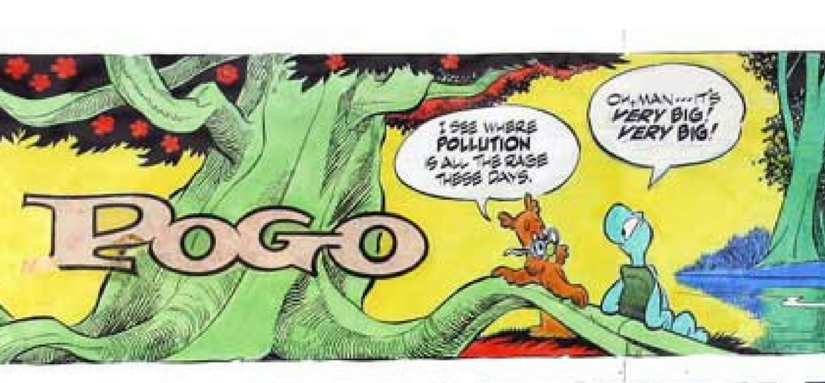
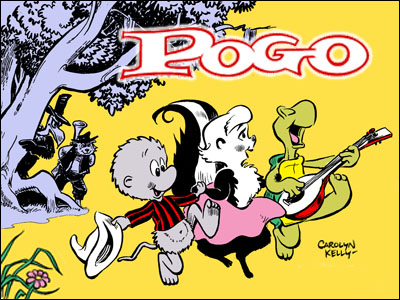
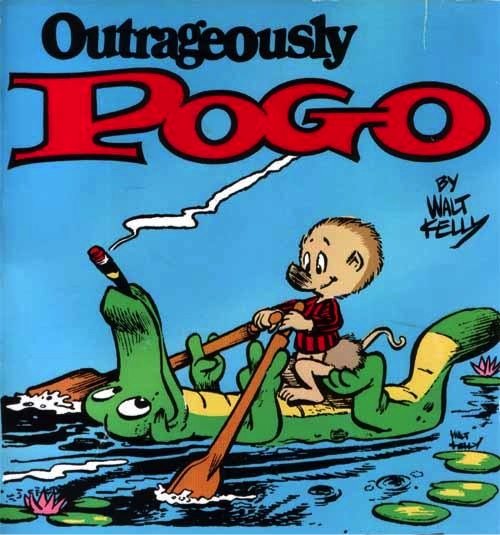

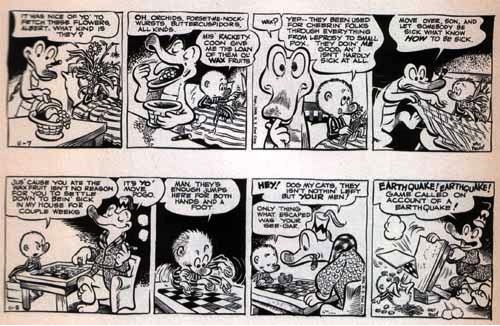


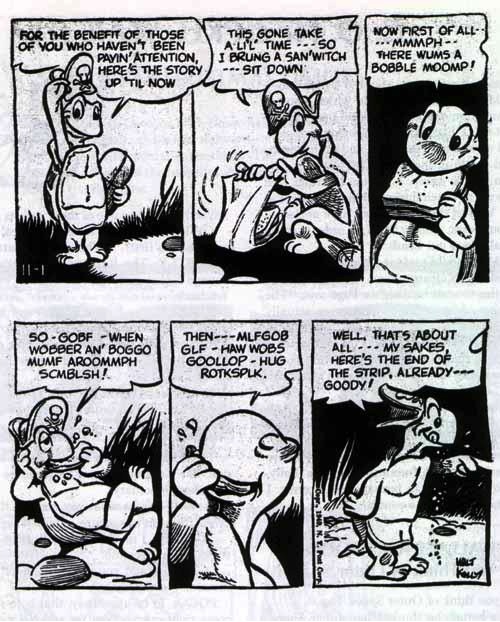



















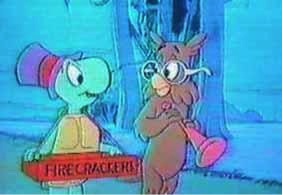
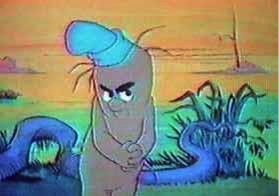


Comments are closed.